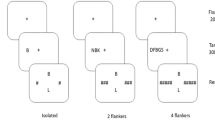Abstract
This study examined differences between adequate and poor readers in phonemic awareness, rapid continuous and confrontation naming, and visual symbol processing. It also investigated which of these skills make independent contributions to word recognition, pseudoword reading, and reading comprehension. Subjects were 170 school referrals of average intelligence, aged 6 to 10 years. The strongest differentiators of adequate and poor readers, with IQ and reading experience controlled, were phonemic awareness, naming speed for letters and pictured objects, and visual symbol processing. Letter naming speed made the largest independent contribution to word recognition, phonemic awareness to pseudoword reading, and object naming speed to reading comprehension. Confrontation picture naming accounted for minimal variance in reading skills, when IQ was controlled. It was concluded that tasks of naming speed, phonemic awareness, and visual symbol processing are valuable components of a diagnostic battery when testing children with possible reading disability.
Similar content being viewed by others
References
Badian, N. A., Duffy, F. H., Als, H. and McAnulty, G. B. (1991). Linguistic profiles of dyslexics and good readers,Annals of Dyslexia 41: 221–245.
Badian, N. A., McAnulty, G. B., Duffy, F. H. and Als, H. (1990). Prediction of dyslexia in kindergarten boys,Annals of Dyslexia 40: 152–169.
Blachman, B. A. (1983). Are we assessing the linguistic factors critical in early reading?,Annals of Dyslexia 33: 91–109.
Bowers, P. G., Steffy, R. and Tate, E. (1988). Comparison of the effects of IQ control methods on memory and naming speed predictors of reading disability,Reading Research Quarterly 23: 304–319.
Bowers, P. G. and Swanson, L. B. (1991). Naming speed deficits in reading disability: Multiple measures of a singular process,Journal of Experimental Child Psychology 51: 195–219.
Bowey, J. A. and Francis, J. (1991). Phonological analysis as a function of age and exposure to reading instruction,Applied Psycholinguistics 12: 91–121.
Cohen, M., Town, P. and Buff, A. (1988). Neurodevelopmental differences in confrontational naming in children,Developmental Neuropsychology 4: 75–81.
Davis, J. M. and Spring, C. (1990). The Digit Naming Speed Test: Its power and incremental validity in identifying children with specific reading disabilities,Psychology in the Schools 27: 15–22.
Denckla, M. B. and Rudel, R. G. (1974). Rapid ‘automatized’ naming of pictured objects, colors, letters and numbers by normal children,Cortex 10: 186–202.
Denckla, M. B. and Rudel, R. (1976). Rapid automatized naming (RAN): Dyslexia differentiated from other learning disabilities,Neuropsychologia 14: 471–479.
Felton, R. H. and Brown, I. S. (1990). Phonological processes as predictors of specific reading skills in children at risk for reading failure,Reading and Writing 2: 39–59.
Felton, R. H., Naylor, C. E. and Wood, F. B. (1990). Neuropsychological profile of adult dyslexics,Brain and Language 39: 485–497.
Felton, R. H. and Wood, F. B. (1989). Cognitive deficits in reading disability and attention deficit disorder,Journal of Learning Disabilities 22: 3–13.
Goswami, U. and Bryant, P. (1990).Phonological skills and learning to read. Hove (UK): Erlbaum Associates.
Jordan, B. T. (1980).Jordan Left-Right Reversal Test. Novato, CA: Academic Therapy Publications.
Kaplan, E., Goodglass, H. and Weintraub, S. (1983).The Boston Naming Test. Philadelphia: Lea and Febiger.
Katz, R. B. (1986). Phonological deficiencies in children with reading disability: Evidence from an object naming task,Cognition 22: 225–257.
Liberman, I. Y. and Shankweiler, D. (1985). Phonology and the problems of learning to read and write,Remedial and Special Education 6: 8–17.
Perfetti, C. A., Beck, I., Bell, L. and Hughes, C. (1987). Phonemic knowledge and learning to read are reciprocal: A longitudinal study of first grade children,Merrill-Palmer Quarterly 33: 283–319.
Rosner, J. (1979).Helping children overcome learning difficulties. New York: Walker and Co.
Rosner, J. and Simon, D. (1971). The Auditory Analysis Test: An initial report,Journal of Learning Disabilities 4: 384–392.
Scarborough, H. S. (1990). Very early language deficits in dyslexic children,Child Development 61: 1728–1743.
Stanovich, K. E. (1988). Explaining the difference between the dyslexic and the garden-variety poor reader: The phonological-core variable-difference model,Journal of Learning Disabilities 21: 590–604.
Stanovich, K. E., Cunningham, A. E. and Cramer, B. B. (1984). Assessing phonological awareness in kindergarten children: Issues of task comparability,Journal of Experimental Child Psychology 38: 175–190.
Stanovich, K. E. and West, R. F. (1989). Exposure to print and orthographic processing,Reading Research Quarterly 24: 402–433.
Wagner, R. K. and Torgesen, J. K. (1987). The nature of phonological processing and its causal role in the acquisition of reading skills,Psychological Bulletin 101: 192–212.
Wechsler, D. (1963).Wechsler Preschool and Primary Scale of Intelligence. New York: Psychological Corporation.
Wechsler, D. (1974).Wechsler Intelligence Scale for Children-Revised. New York: Psychological Corporation.
Wolf, M. (1984). Naming, reading, and the dyslexias: A longitudinal overview,Annals of Dyslexia 34: 87–115.
Wolf, M. (1986). Rapid alternating stimulus naming in the developmental dyslexia,Brain and Language 27: 360–379.
Wolf, M. (1991). Naming speed and reading: The contribution of the cognitive neurosciences,Reading Research Quarterly 26: 123–141.
Wolf, M., Bally, H. and Morris, R. (1986). Automaticity, retrieval processes and reading: A longitudinal study in average and impaired readers,Child Development 57: 988–1000.
Wolf, M. and Goodglass, H. (1986). Dyslexia, dysnomia, and lexical retrieval: A longitudinal investigation,Brain and Language 28: 154–168.
Wolf, M. and Obregon, M. (1992). Early naming deficits, developmental dyslexia, and a specific deficit hypothesis,Brain and Language 42: 219–247.
Woodcock, R. W. (1987).Woodcock Reading Mastery Tests-Revised. Circle Pines, MN: American Guidance Services.
Yopp, H. K. (1988). The validity and reliability of phonemic awareness tests,Reading Research Quarterly 23: 159–177.
Author information
Authors and Affiliations
Rights and permissions
About this article
Cite this article
Badian, N.A. Phonemic awareness, naming, visual symbol processing, and reading. Read Writ 5, 87–100 (1993). https://doi.org/10.1007/BF01026920
Issue Date:
DOI: https://doi.org/10.1007/BF01026920




